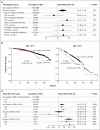Age-related clonal hematopoiesis associated with adverse outcomes
- PMID: 25426837
- PMCID: PMC4306669
- DOI: 10.1056/NEJMoa1408617
Age-related clonal hematopoiesis associated with adverse outcomes
Abstract
Background: The incidence of hematologic cancers increases with age. These cancers are associated with recurrent somatic mutations in specific genes. We hypothesized that such mutations would be detectable in the blood of some persons who are not known to have hematologic disorders.
Methods: We analyzed whole-exome sequencing data from DNA in the peripheral-blood cells of 17,182 persons who were unselected for hematologic phenotypes. We looked for somatic mutations by identifying previously characterized single-nucleotide variants and small insertions or deletions in 160 genes that are recurrently mutated in hematologic cancers. The presence of mutations was analyzed for an association with hematologic phenotypes, survival, and cardiovascular events.
Results: Detectable somatic mutations were rare in persons younger than 40 years of age but rose appreciably in frequency with age. Among persons 70 to 79 years of age, 80 to 89 years of age, and 90 to 108 years of age, these clonal mutations were observed in 9.5% (219 of 2300 persons), 11.7% (37 of 317), and 18.4% (19 of 103), respectively. The majority of the variants occurred in three genes: DNMT3A, TET2, and ASXL1. The presence of a somatic mutation was associated with an increase in the risk of hematologic cancer (hazard ratio, 11.1; 95% confidence interval [CI], 3.9 to 32.6), an increase in all-cause mortality (hazard ratio, 1.4; 95% CI, 1.1 to 1.8), and increases in the risks of incident coronary heart disease (hazard ratio, 2.0; 95% CI, 1.2 to 3.4) and ischemic stroke (hazard ratio, 2.6; 95% CI, 1.4 to 4.8).
Conclusions: Age-related clonal hematopoiesis is a common condition that is associated with increases in the risk of hematologic cancer and in all-cause mortality, with the latter possibly due to an increased risk of cardiovascular disease. (Funded by the National Institutes of Health and others.).
Figures




Comment in
-
Clone wars--the emergence of neoplastic blood-cell clones with aging.N Engl J Med. 2014 Dec 25;371(26):2523-5. doi: 10.1056/NEJMe1412902. Epub 2014 Nov 26. N Engl J Med. 2014. PMID: 25426835 No abstract available.
-
Human genetics: somatic mutations linked to future disease risk.Nat Rev Genet. 2015 Feb;16(2):69. doi: 10.1038/nrg3889. Epub 2014 Dec 23. Nat Rev Genet. 2015. PMID: 25534323 No abstract available.
References
-
- Nowell PC. The clonal evolution of tumor cell populations. Science. 1976;194:23–8. - PubMed
-
- Kyle RA, Therneau TM, Rajkumar SV, et al. A long-term study of prognosis in monoclonal gammopathy of undetermined significance. N Engl J Med. 2002;346:564–9. - PubMed
-
- Rawstron AC, Bennett FL, O'Connor SJ, et al. Monoclonal B-cell lymphocytosis and chronic lymphocytic leukemia. N Engl J Med. 2008;359:575–83. - PubMed
-
- Busque L, Mio R, Mattioli J, et al. Nonrandom X-inactivation patterns in normal females: lyonization ratios vary with age. Blood. 1996;88:59–65. - PubMed
-
- Champion KM, Gilbert JG, Asimakopoulos FA, Hinshelwood S, Green AR. Clonal haemopoiesis in normal elderly women: implications for the myeloproliferative disorders and myelodysplastic syndromes. Br J Haematol. 1997;97:920–6. - PubMed
Publication types
MeSH terms
Grants and funding
- T32 HL066987/HL/NHLBI NIH HHS/United States
- 090367/WT_/Wellcome Trust/United Kingdom
- U01 DK085545/DK/NIDDK NIH HHS/United States
- P30AG038072/AG/NIA NIH HHS/United States
- T32 CA009216/CA/NCI NIH HHS/United States
- DK088389/DK/NIDDK NIH HHS/United States
- 5T32HL066987/HL/NHLBI NIH HHS/United States
- R01HL082945/HL/NHLBI NIH HHS/United States
- U01 DK085501/DK/NIDDK NIH HHS/United States
- 083948/WT_/Wellcome Trust/United Kingdom
- R01 AG042188/AG/NIA NIH HHS/United States
- 098381/WT_/Wellcome Trust/United Kingdom
- U54 HG003067/HG/NHGRI NIH HHS/United States
- U01 DK085524/DK/NIDDK NIH HHS/United States
- P01 AG021654/AG/NIA NIH HHS/United States
- G0900747/MRC_/Medical Research Council/United Kingdom
- R01 HL082945/HL/NHLBI NIH HHS/United States
- P01AG021654/AG/NIA NIH HHS/United States
- P01 CA066996/CA/NCI NIH HHS/United States
- T32 CA009172/CA/NCI NIH HHS/United States
- RC2 DK088389/DK/NIDDK NIH HHS/United States
- DP2 DK098087/DK/NIDDK NIH HHS/United States
- U01 DK085526/DK/NIDDK NIH HHS/United States
- U01 DK085584/DK/NIDDK NIH HHS/United States
- P30 AG038072/AG/NIA NIH HHS/United States
- 090532/WT_/Wellcome Trust/United Kingdom
- 1R01AG042188/AG/NIA NIH HHS/United States
- P30 DK020572/DK/NIDDK NIH HHS/United States
- 085475/WT_/Wellcome Trust/United Kingdom
- WT_/Wellcome Trust/United Kingdom
- G0900747 91070/MRC_/Medical Research Council/United Kingdom
- G0601261/MRC_/Medical Research Council/United Kingdom
LinkOut - more resources
Full Text Sources
Other Literature Sources
Medical
